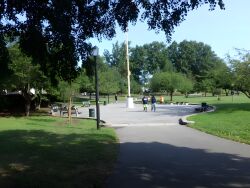Archie Spigner Park
Archie Spigner Park
What was here before?
In 1861, landowners John and Maria Remsen sold Mill Pond, Mill Brook, and the land surrounding the bodies of water, including this property, for $4,250 to the Town of Jamaica for its water supply system. In the deed, the parcel is defined using “a certain Buttonwood tree” as a reference point. The property and the rest of the area were wooded in the 19th century.
Manhattan developers bought the nearby Francis family farm on Linden Boulevard in 1892 and laid out a plan for another town - St. Albans. A post office was built, and the Long Island Railroad station opened on July 1, 1898. The St. Albans Golf Club and housing development in the 1920s marked the path towards suburbanization, spurred by the arrival of the railroad. By 1939, some 30,000 people lived in St. Albans.
In the 1950s and 1960s, the population of St. Albans became more diverse with the influx of African Americans and included a number of famous musicians such as Lena Horne, Count Basie, and Fats Waller who lived in the affluent enclave of the Addisleigh Park Historic District.
How did this site become a park?
In 1898, the property was transferred to the City of New York upon consolidation of the five boroughs. Parks acquired most of the land in 1914, and it was named St. Albans Memorial Park in 1932. Subsequent parcels were added between 1936 and 1968. By the 1930s, the formerly wooded property acquired a more formal design, with a central lawn and surrounding pathways.
The park is divided by Merrick Boulevard. To the west is a grass baseball diamond and to the east is a large open grass area, several sitting areas, basketball courts, handball courts, two tennis courts, playgrounds, spray showers, and a public restroom.
The lawn was named Musician’s Oval in 2021 after the neighborhood’s noted talents. It is a favorite location for stargazing and was renovated in 2001 with paved constellations at six entrances with the date, time, and orientation at which they can be seen best. The flagpole to the north of the lawn is intended to act as a timepiece telling the hour with its shadow.
Who is this park named for?
The park was renamed in 2022 in honor of Archie Spigner (1928-2020), a local politician who served for 27 years as a City Councilman for District 27 in southeast Queens.
Born in Orangeburg, South Carolina, Spigner moved to New York City with his family in search for a better life. He attended Central Needle Trades High School, now Fashion Industries High School, a vocational school created through the Works Progress Administration (WPA). He found employment at a shoe factory and then enrolled in the Jefferson School of Social Science where he learned about labor and organizing. He later became a New York City bus driver and joined the Negro American Labor Council founded by A. Philip Randolph. This organization introduced him to various political leaders including Guy Brewer and Kenneth N. Browne, who inspired him to further his education. He graduated from Queens College with a degree in Political Science in 1972.
In 1974, Spigner was elected to the City Council. During his tenure, he advocated for education, infrastructure, and the underserved community. He was integral in the founding of York College and the Archer Avenue subway extension line which made it easier to commute there.
Spigner left office in 2001 due to term limits but remained District Leader of the United Democratic Club of Queens until his death in 2020. He was remembered by his close colleagues as a champion of southeastern Queens.
Check out your park's Vital Signs
Clean & Safe
Green & Resilient
Empowered & Engaged Users
Share your feedback or learn more about how this park is part of a
Vital Park System










